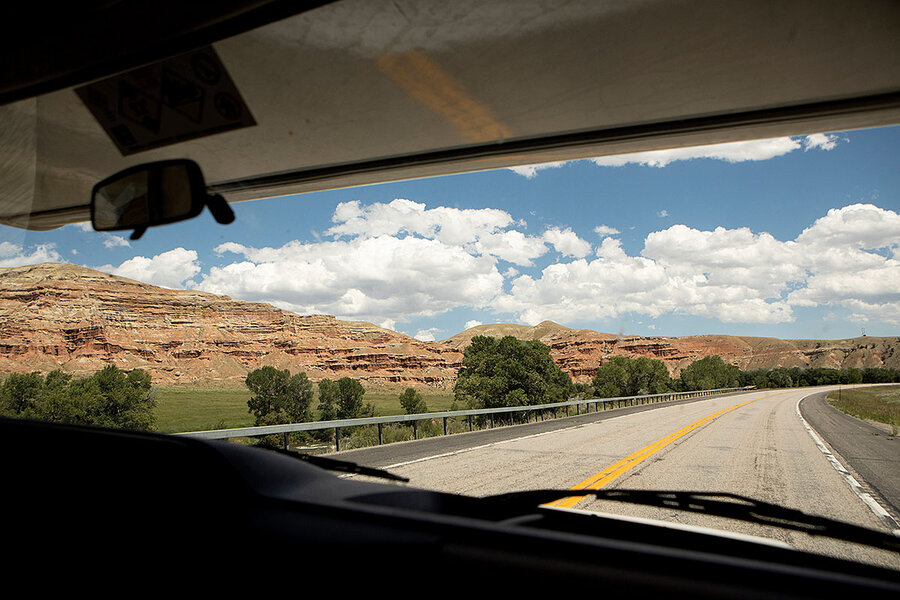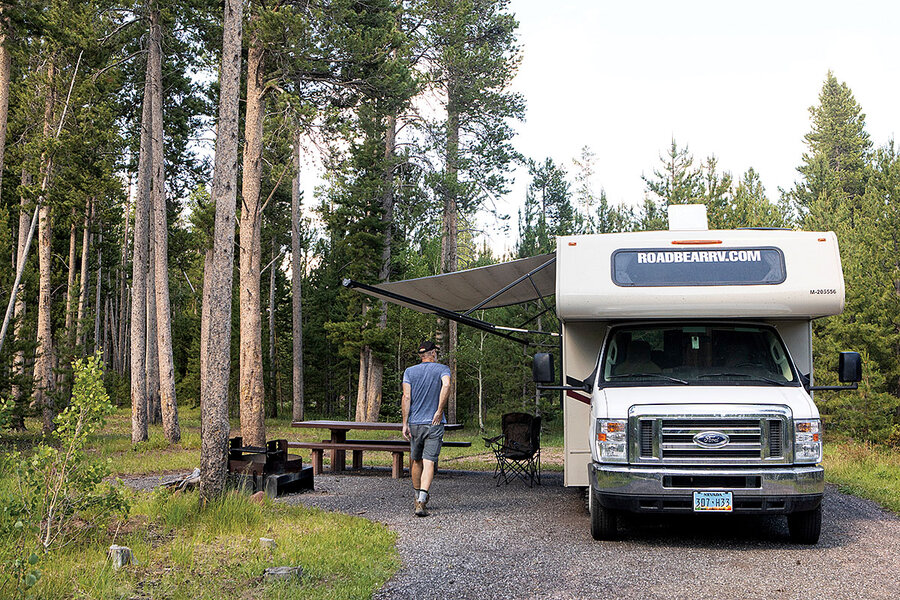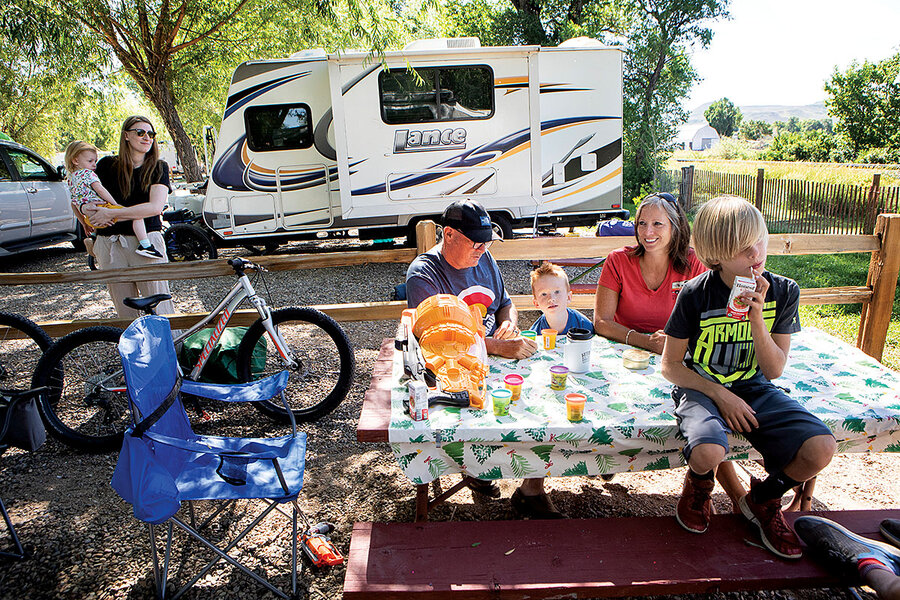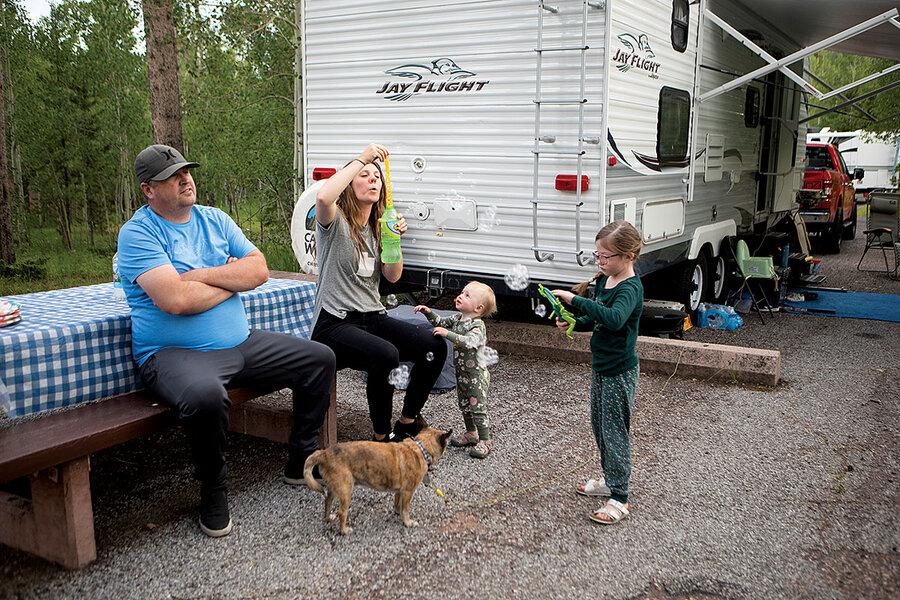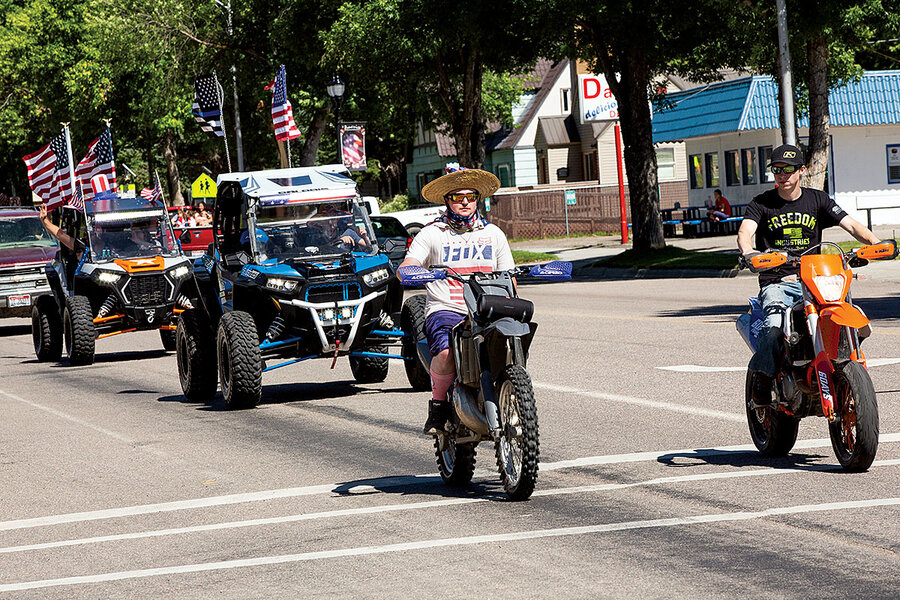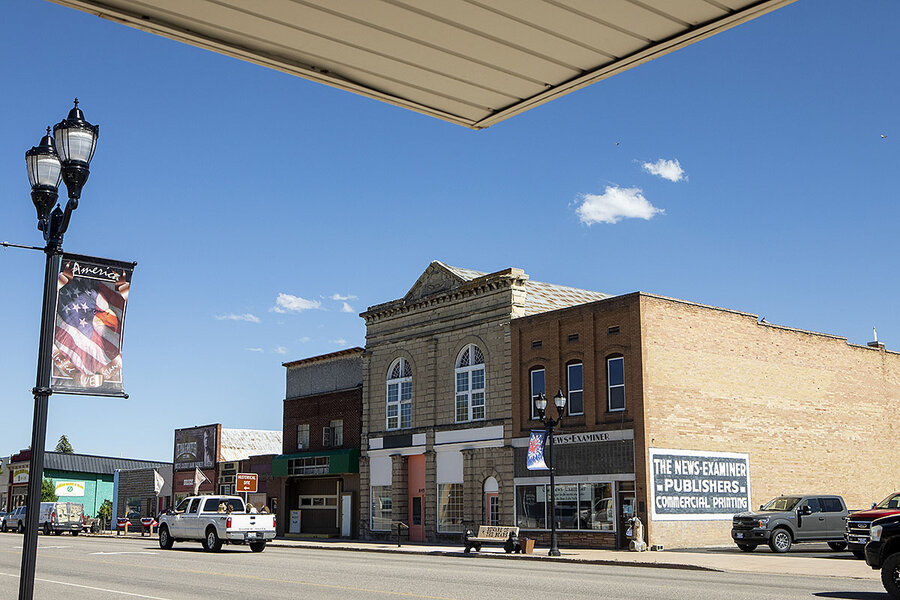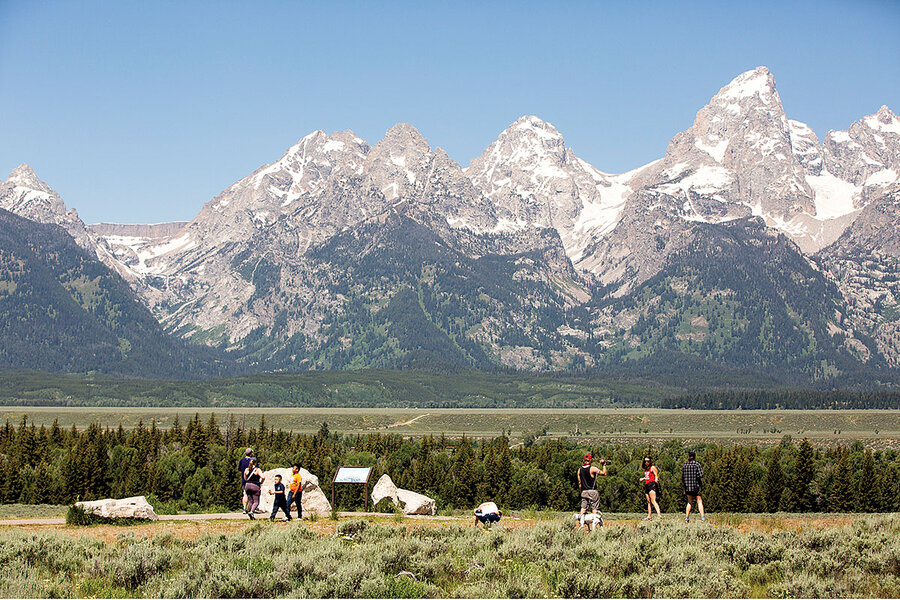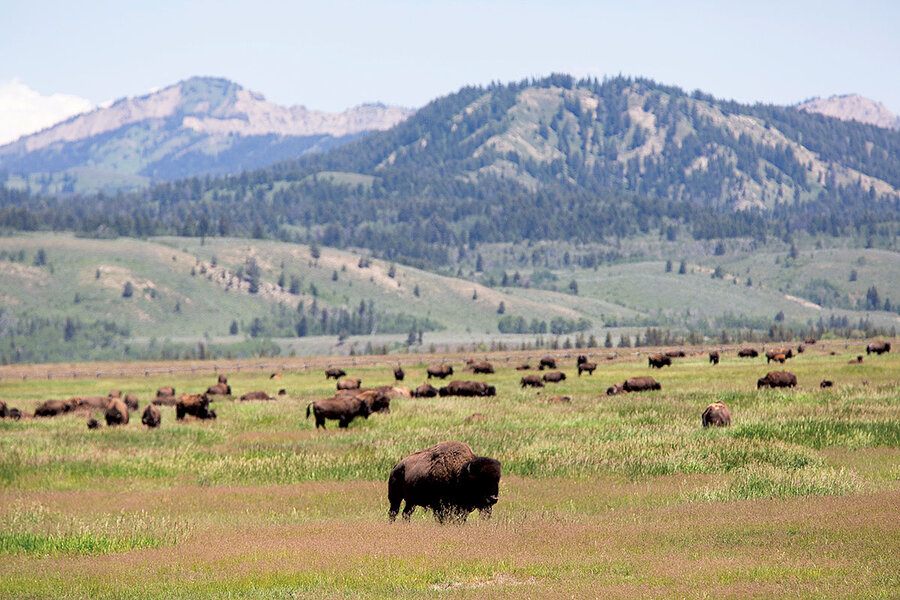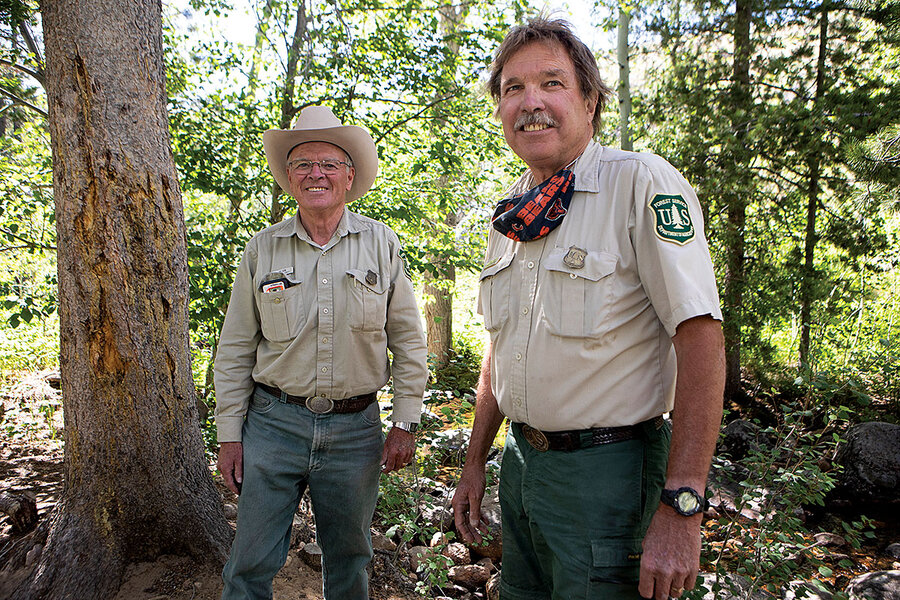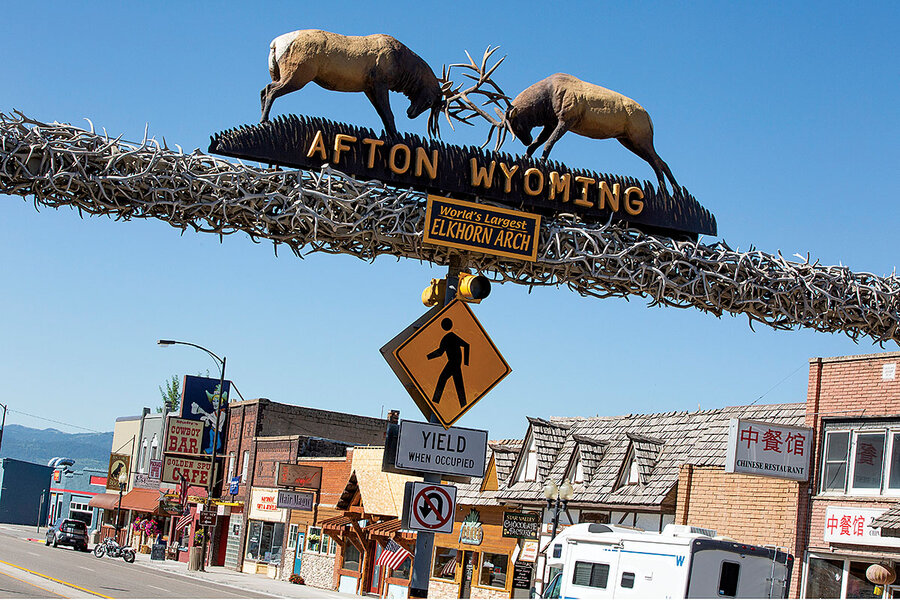Travels with Maybell: Looking for ‘normal’ in an RV
Loading...
| Denver
At Ashley National Forest’s Lodgepole Campground in Utah, Angie and Justin Woodward have a 32-foot RV. Their campsite is festooned with the right camp chairs for each family member, which includes their four children. There’s also Tiger, a Chihuahua mix who appears to own the forest.
The three oldest children eagerly share their favorite camping destinations across Utah. They’ve done this camping thing before. “But not as much as now!” says Mr. Woodward. “It’s not normal back home,” he says. “But this” – he gestures at the activity all around us – “this is normal.”
Why We Wrote This
For many Americans who longed to vacation this summer, motor homes served as mobile safe harbors. Such travels yielded beauty, solitude, camaraderie, and a sense, if just for a moment, that the pandemic isn’t happening.
Over five days during the pandemic summer of 2020, correspondent Michael S. Hopkins and his wife, Monitor photographer Melanie Stetson Freeman, traveled through four states in the western United States aboard a rented RV, aka Maybell. Their editorial mission was to see what freedom feels like after confinement. To learn what their fellow travelers were doing, seeing, sensing, seeking. To meet people like the Woodwards.
“We wanted normal, but got more,” Michael writes. “We got beauty. We got solace. What we did on our summer road trip was what a lot of Americans sought to do on theirs: For a small time, we got peace.”
Call her “Maybell,” which is just dowdy enough. She is 22 feet long, and looks like a box stapled on a U-Haul truck. Bed in rear (queen!), another over the cab, “full” bath, stove-top, banquette table, fridge. A sailboat-style miracle of space planning on a platform so jangly you wonder whether rivets will pop on the highway.
True, she is not the Instagram-ready little camper van we’d sought to rent. (Cool, Maybell isn’t. Cool, however, is an extra $100 a night.) But she is ours. And she is about to ferry me – with my wife, Monitor photographer Melanie Stetson Freeman – through four states in five days during our pandemic summer of 2020. We have flown at dawn from Boston to Denver, and now are relieved when our little recreational vehicle is handed to us smelling of disinfectant and open windows. Without fanfare we are given a manual, some pointers, and solitude. We’ll have to sort out our relationship with Maybell on our own. So we wrangle her through surface streets to a supermarket for provisions, then turn west. Which means over the Continental Divide. Which means climbing. Not, it turns out, Maybell’s favorite pastime.
“Can’t we go any faster?” asks Melanie as we crawl upward, traffic pooling around us. I pin the accelerator to the floor. Maybell’s engine roars. Maybell’s speedometer stands still. We crawl on.
Why We Wrote This
For many Americans who longed to vacation this summer, motor homes served as mobile safe harbors. Such travels yielded beauty, solitude, camaraderie, and a sense, if just for a moment, that the pandemic isn’t happening.
But that gives us more time to look, which is everything. In just hours we pass through four kinds of landscape – from blond foothills to rock-strewn canyons to spruce-blackened mountainsides, and finally, cresting at 11,000 feet, to tender alpine meadows, where streams curl through stands of aspen, their tiny leaves shimmering like sequins. When we emerge from the Eisenhower Tunnel on Interstate 70 an hour west of Denver the world falls away in front of us, the highway clinging to a parapet while far below spreads a vast valley, its grasses lemon-green in the slanting late-day light.
Melanie and I just look at each other. After all our sheltered-in-place months in the COVID-19-battered Northeast, we are, finally, somewhere else.
A warm welcome
As evening falls, we pull into the Kampgrounds of America (KOA) site in Craig, Colorado, where we have a reservation. Good thing, because the sites are full with everything from pop-up trailers to RVs the size and sheen of Beyoncé’s tour bus. I go to check in and find a smiling, can-do man behind the counter – but none of the acrylic barriers or this-is-what-6-feet-looks-like signs I’d grown used to in Massachusetts. From the doorway I gesture with my mask in hand and raise my eyebrows. “Nah,” he says. “Not here. Not required in our county. Come in!”
This is Chad Hodnefield, owner of the campground with his wife, Kristi. Three years ago he’d been running a poultry farm in Wisconsin (“tough world, agriculture”) when he traded that life for this one. I ask him how business is. “Hard, when the lockdowns came,” he says. Reservations were canceled. New ones didn’t appear.
“Then it changed,” he notes. “August reservations are up 15%, and people are staying longer. Not so many one-nighters, more fours and fives.”
He looks at our registration form. “Massachusetts! What brings you?”
The RV explosion, I tell him. Doubtless he knows about the motor home sales backlogs and waiting lists, the 49% increase in Airstream deliveries, how rental reservations through RVshare had risen 1,000% between early April and late May. Americans have decided to hit the road, virus or no virus, with RVs their mobile safe harbor.
Our editorial mission, I explain, is to join the tribe. See what freedom feels like after confinement. Learn what our fellow travelers are doing, seeing, sensing, seeking. Not to mention, I add, part of our trip overlaps with a camping itinerary I’d experienced 40 years ago as a child. What would that feel like?
“You’ve come to the right place,” Mr. Hodnefield says. He is eager to talk. “We’re seeing all that.”
I wonder how the guests feel. “Grateful!” he says, like he’d been waiting to be asked. “Relieved. It’s like, ‘Phew, thank you for not going overboard [with COVID-19 measures].’ I hear stuff like, ‘We’ve been here only a few days and it’s like it’s not happening.’”
He grins and shrugs. “Isn’t that what we all want?”
We meet fellow campers Deborah and Richard Lamkin, from Cisco, Texas, with their 40-foot diesel coach and its additional “toy-hauler” trailer, out of which emerge an off-road buggy complete with roll bars and a matching pair of electric bikes. “I mean, if you have to isolate ...” says Ms. Lamkin, waving at her transportable homestead.
John and Sue Pack are isolating, too – but en masse. They and their extended family of children and grandchildren are in adjacent sites, having chosen Craig as the midpoint among various homes around Greater Salt Lake City and Castle Rock, Colorado. After months of distancing, this is how to convene, they’ve decided: in the open air, around a cookstove. They are post-meal and pre-cleanup when we catch them – a dozen friendly people splayed on benches and camp chairs, teasing and laughing, kids appearing from nowhere to jump in someone’s lap and then disappearing just as fast. A regular family, cherishing a regular time. “This is our bubble,” says Mr. Pack.
That night the temperature drops from 90 degrees to 50. The air is delicious. We keep Maybell’s windows open and still she is snug.
The campground is full but quiet. There are drifts of woodsmoke, notes of laughter that come and go, sometimes the sound of a far-off truck. The night is starry.
We are aware of unseen people gathered all around us, poking at embers, whispering, looking at the sky, tucking into bed. It feels magnificent.
Like it’s not happening.
Cows on the road
On the way to Utah, before passing the town of Dinosaur, Colorado, we are stopped by a cattle drive. A mixed posse of wranglers (one woman, two men), on horseback and an ATV, keep the long stream of lowing cows moving across the road.
At the general store in Maybell, Colorado (no relation), we stop for gas – so much gas. The proprietor tells us about her daughter, a teacher who is worried about returning to school. “I told her, ‘You gotta have schools open; kids suffer without school. You can’t live in fear.’”
In Utah the land is rising again, but either we’ve grown used to Maybell or she’s grown used to us. The rattles aren’t as noticeable, and we let the hills slow us as they choose. We pull in and take the last available site in Ashley National Forest’s Lodgepole Campground. Unlike the cheek-by-jowl arrangements at the KOA and other private campsites, here on national forest land we are isolated among tall thin pines, the other sites scattered out of view along an access loop. No hookups, though – no electricity, water, or sewer connections. No problem, says Maybell. I’m self-sufficient.
We walk the loop, greeting communities of campers in every kind of rig. Among them are Angie and Justin Woodward in a 32-foot RV with their four children plus Tiger, a Chihuahua mix who appears to own the forest. Their site is festooned with the right camp chairs for each family member. Everyone has bikes. On their cloth-covered picnic table lie games, a stove, a cooler, and containers of craft materials and teaching supplies. They invite Melanie and me for s’mores, and the three oldest children eagerly regale us with their favorite camping destinations across Utah. They’ve done this camping thing before.
“But not as much as now!” says Mr. Woodward. The school shutdowns mean schedule flexibility, even if some educating has to take place in the wild. “It’s not normal back home,” he says. “But this” – he gestures at the activity all around us – “this is normal.”
The Woodwards represent two observations that were inescapable throughout our trip. One: The campers we meet are pros. For all the evidence of the pandemic-prompted RV surge, it’s still the aficionados, not the newbies, who dominate the road – and everyone we talk to claims, like the Woodwards, to be camping more than before.
And two: There may be no impulse more unstoppable than the human desire for “normal.”
On the Fourth of July
From the Lodgepole Campground, we journey north, gliding gradually lower from 8,000 feet over bald mountains and broad canyons. We drive with Maybell’s windows down, the breeze blowing her curtains, our skin smooth and papery in the high dry air. It is the Fourth of July.
We’ve reserved another KOA campground – getting reservations anywhere has been difficult – this one in Montpelier, Idaho, a town on a high plain edged by hills to the north. But before reaching the campground we idle through the community of 2,500 people itself, only to find ourselves suddenly inserted into a stream of vehicles rolling in both directions on the main street. Puzzled, we pull Maybell to the curb and watch.
The vehicles are of every kind: pickups, convertibles, dirt bikes, jalopies. Some new, some old, some seemingly reserved for this purpose only. All are jammed with people – adults, teenagers, children – and most are decorated with flags or banners or signs. Sometimes the drivers themselves are decorated. We see a shirtless Uncle Sam pop a wheelie. Loudspeakers wail.
It seems the town’s official July Fourth parade has been canceled due to virus precautions, so residents have taken it upon themselves, explains a local, to spend the afternoon cruising up and down the main street. Later the Montpelier News-Examiner would report it as the revival of a time-honored tradition: “drag[ging] main as in the olden days.”
But back at the campground we learn from Brenda Reno that the revival has sadder origins. In late April, Montpelier suffered a tragic spate of five suicides in three weeks (with two more “possibles” being investigated, according to police). Though Idaho had experienced very few COVID-19 cases up to that point, the economic slowdowns had hit places like Montpelier hard. When a resident launched an ad hoc Facebook campaign proposing people “drag main” to show support for the victims’ families, hundreds of cars showed up. “It helped people,” says Ms. Reno, who is closing the campground snack bar. “Anything to get out finally, to be together even if we couldn’t be. Anything to feel normal.” Two weeks later they would drag main again.
As Ms. Reno speaks, twilight is falling. The campground pool that had been thick with splashing children has grown calm. The rooftop air conditioners of the giant motor homes hum in the heat.
Gradually we notice people emerging from rigs and cabins and shower huts, calling to one another, passing instructions, getting in cars. “What’s happening?” we ask Ms. Reno. “Oh, fireworks,” she says. “Everybody’s going to the fireworks. All my kids are. Not sure if I’m going or not.”
In coming days the News-Examiner would testify that “the fireworks were as good or better than ever, and everyone had fun.”
Inside Maybell, we didn’t hear them.
From ravines to granite cliffs
From Montpelier to Lander, Wyoming, would be our trip’s longest leg. Also its most beautiful.
We zigzag northeast, gaining altitude. Tawny ravines give way to fir-dotted slopes, then granite cliffs. At the town of Alpine, Wyoming, we pick up the Snake River, swift and chalky in the sunshine, and follow it – the already fresh air now tasting fresher.
We spill through the mountain town of Jackson, then straight up Route 89 with the Grand Tetons rising on our left, their serrated profile more heart-stopping than any mountains west of the Matterhorn. We pull into a roadside overlook, park, and eat lunch. We have sandwiches and some fruit, and we settle in Maybell’s little banquette and look at the mountains filling our wide-open windows. We sit a long time. We don’t talk.
Underway again, we haven’t traveled far when we come upon cars and campers and bus-sized RVs inexplicably pulling off the shoulderless road. Then we see why.
Spread before us, from as near as 50 yards to as far as you can see, are bison. A thousand bison. They flood the entire valley, their mammoth heads and forequarters tapering to their laughable billy-goat behinds. A preposterous animal, preposterously beautiful.
And maybe we can be forgiven right then for wondering, Where are we? How did we get here? Just a few days earlier we’d been stuck in our New England home, weary of confinement. And now: this.
The next day, outside Lander in the Shoshone National Forest, we sit by a stream with forest rangers Bill Lee and Del Nelson. They have been working in the area for 41 and 45 years, respectively, and are still coiled with energy. We describe what we’ve seen on the trip so far, and they grin like there is a secret they want to share but can’t; they know we have to learn it for ourselves. Finally Mr. Nelson ventures: “It’s therapeutic, being in nature, isn’t it? It’s medicinal, if you will.”
Yes, it is medicinal. It is for Melanie and me, at least. Maybe for anyone.
The two men do everything that operating the Shoshone requires – “tickets to toilets,” as Mr. Lee puts it. When they started opening campgrounds on May 20, Mr. Lee bought $3,000 worth of disinfectant gear and cleaned bathrooms in a hazmat suit. Now, their wives worry more than they do, though the men still don masks around people and keep safely separate. Visitation at the national forest is up. At trailheads, the rangers are encountering more people “who don’t know their way around.” Which is a good thing, they say. More people getting the medicine.
We stay two nights in Lander – the first in Sinks Canyon State Park, the second just a couple of miles farther up the road in the Shoshone. That last night we park between canyon walls that frame the steeply falling Popo Agie River, its crystalline waters just 20 steps from Maybell’s door. All night we can hear the river tumbling in the dark.
Remembering an air show
Our trip is coming to an end, but I’ve left something out. Sometime on the third morning, Melanie and I catch up with my past.
We are herding Maybell up Route 89 through Wyoming’s Star Valley when the highway transforms into the main street of the town of Afton. Suddenly, through the gaps in buildings, we see a paved field full of airplanes – tiny planes, open cockpits, painted like a circus. And I remember: I’ve been here before.
Forty years ago as a kid with my brother, sister, and parents I’d spent an overcast afternoon in this same place during a family trip that took us from our New Jersey home to California. The journey was an awakening – a sudden confrontation with the country’s size, a summons to imagine lives nothing like mine in places nothing like my own.
I remember lying unseen in the “way back” of our station wagon outside a Minot, North Dakota, supermarket overhearing two teenage girls talk about the boys they’d see at the state fair that night. I remember shooting baskets on a dirt court with a cowhand at a dude ranch in Chugwater, Wyoming. I remember a campground where I met an old man traveling solo in a makeshift van, who sat with me under a tree and explained which kind of rod worked for which kind of fish.
Most vividly, though, I remember seeing an air show in Afton – I’d forgotten the name of the place until stumbling on it. A tinny loudspeaker introduced successive “acts”: a hammering old World War II Mustang, a wing-walking woman (who was tethered to a strut but appeared no less daring for it), and little biplanes that climbed straight up before sliding impossibly backward into tumbles and loops and then racing past us upside down just beyond our chain-link fence. I remember everything about the show, but mostly I remember the rapt face of my father, who had learned to fly small planes himself.
And now here Melanie and I are, walking among those planes, taking pictures of them on a quiet, diamond-bright morning. I send the pictures to my dad.
So little has changed, is the point. And maybe that is what we’ve learned as we have finally gotten out, and gotten away, and traveled through landscapes dismissive of a pandemic, among people undaunted by it. We wanted what everyone wants and what so many we met have at least for a moment achieved: Like it’s not happening. We wanted normal, but got more. We got beauty. We got solace. What we did on our summer road trip was what a lot of Americans sought to do on theirs: For a small time, we got peace.
We did not, alas, get to keep Maybell. We had to give her back. “But don’t worry,” we said to her at the depot. “We’ll return for you.” And it may have been my imagination, but I think she was glad.
She wants to go again.




